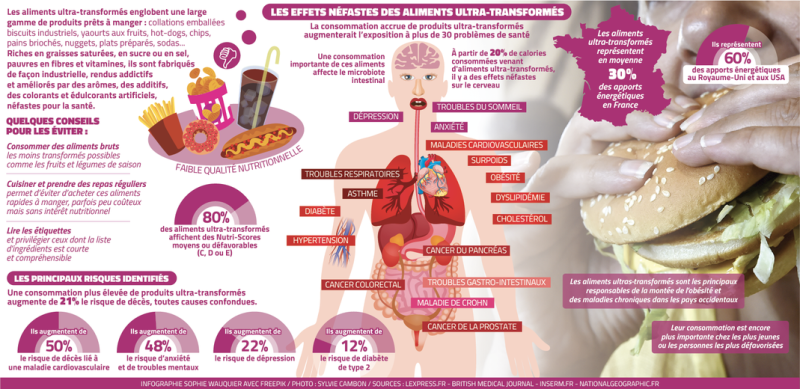“Industrial perlimpinpin powder”: a new study warns against ultra-processed foods

Le contenu de l'assiette est déterminant pour la bonne santé de chacun. Midi Libre – YVES ESTIVALS
Diabetes, obesity, cardiovascular diseases, colorectal cancer… but also depression, anxiety, sleep disorders, the increasingly documented impact of the consumption of ultra-processed foods on health, is the subject of a new study in the British Medical Journal.
A study published in the British medical journal links the consumption of ultra-processed products to numerous health problems. Anthony Fardet, researcher in preventive and sustainable food at Inrae in Clermont-Ferrand, and author of the book "Stop ultra-processed foods, let's eat real" (ed. Thierry Souccar) has been warning on the subject for years.

Anthony Fardet warns of the dangers of ultra-processed foods. DR
The problem of ultra-processed foods is not new, you wrote a book on this subject in 2017. The conclusions of a new study, published in the British Medical Journal, which confirm the risks of cancer, cardiovascular diseases, depression… does it still surprise you ?
No. We have reached 204 epidemiological studies since 2012 and we have 80 cohort studies, 55 review reviews, meta-analyses, systematic reviews… they almost all go in the same direction.
There are more or less robust studies, we will always need to accumulate more evidence to reinforce robustness. But when you have so many studies that converge in the same direction, we are not far from approaching a causal link. The proof is the cause, it’s when you are 100% sure. It's a bit like a police investigation. When we don't have proof, we accumulate clues to get closer.
We are still in a stage of accumulating clues on ultra-processed products ?
There is sufficient accumulation of evidence for us to apply the precautionary principle. Thus, the recommendation to eat five fruits and vegetables per day is only based on epidemiology, not causality.
There are none today regarding ultra-processed products ?
In the fourth national nutrition and health plan (PNNS4), the High Council of Public Health recommended reducing the consumption of ultra-processed products by 20%, but this has fallen a little short. silence. And we don't know if we're talking about calories or weight. I think the next PNNS, probably under construction, will make clearer recommendations on ultra-processed foods.
"The purpose of these foods is to replace real foods"
What is the trend in the consumption of ultra-processed products ?
We assessed the share of change in the consumption of ultra-processed foods from 1998 to 2015: we noted a slight increase among children because they are often the most targeted, but in the adult population, it was rather stable. The market is quite saturated in France but the growth is immense and in double digits in emerging and developing countries.
Overall, southern European products consume fewer calories per day than northern European countries because I think there are more entrenched culinary traditions. But we are still at 34% of calories coming from ultra-processed products in France, and we estimated, in our studies, that among children, we were at 46% in 2015. This is a figure which must be confirmed. In theory, we should not exceed 10% to 15% of calories from ultra-processed products per day.
How to describe, in a simple way, an ultra-processed food ?
The definition is quite simple and very clear: an ultra-processed food is a food that contains at least one ultra-processing marker, what we call a MUT. The purpose of MUTs is to modify the organoleptic or sensory properties of the food; i.e. taste, color, aroma or texture. We are in cosmetics and the artificialization of food.
The big question is how to identify these MUTs. There are four of them. We don't talk about the conservatives, that's another problem. MUTs are cosmetic additives, texturizers, taste modifiers and colorings. You also have all the flavors, natural, synthetic and flavor extracts, then sugars, fats, lipids, proteins or ultra-processed fibers, for example maltodextrin , hydrogenated fats, hydrolyzed proteins… These are all “bricks” resulting from a deconstruction of the food matrix.
The fourth MUT which is not on the packaging relates to technological processes applied to food: cooking-extrusion and blowing are the main ones, and are mainly applied to food. starchy foods.

What is the objective, to make it more beautiful, more appetizing, to change the taste ?
That's it. They have cosmetic vocations, and by definition, cosmetics are not essential. For example, extrusion cooking and blowing make it possible to make fun, crumbly, crunchy products for children, such as breakfast cereals. These are very friable matrices, very quickly digested and with a high glycemic index.
The other common treatment of ultra-transformation is of course "cracking" food.
"We create new foods, which do not exist in a natural state"
What do you call cracking?
We isolate the basic building blocks of the food by deconstructing the matrices, the sugars, the lipids, the proteins… then we can even modify them by chemical/enzymatic means for example. The problem with this cracking is that it is applied to very few foods on the planet. We have very low biodiversity because the objective is to have standardized ultra-processed ingredients (MUT) all year round, outside of the seasons. We're going to crack, for sugars, anything starchy, potatoes, rice, corn. For proteins, we will mainly crack pea and soy, eggs, or milk, and then meat minerals for collagen…
Then, there are two solutions: either we do recombinations of elementary bricks to make what we call false foods, that is to say completely reconstituted new foods which do not contain any ingredients. do not exist in nature, substitutes for animal products, sodas, chocolate bars, milks/infant formulas. Or, we add these markers to real foods to correct acidity, mask an undesirable taste, improve a texture… in prepared dishes. These are the two major groups of ultra-processed foods.
Once again, we're not talking about conservatives…
No, with preservatives, we are not in cosmetics, which does not mean that there are not problems. . Here, we are in the cosmetic surgery of food: if we were to take the example of the face, either we make a new face, or we correct a pimple, redness of the skin, wrinkles.
"The longer the list, the less understandable the words, the more wary you should be"
How do we identify MUTs on packaging ?
If you don't know the nature of MUT foods, it's still complicated. For cosmetic additives, normally there is an "E" ahead, but manufacturers realized that people were afraid when the word E was written there, they are increasingly putting the chemical name without the "E". < /p>
The longer the list, the less understandable the words are, the more wary you should be. When there are more than five ingredients, there is an eight out of ten chance that the food is an ultra-processed product. And if you have low-fat or fortified foods, that's not the case. is almost always ultra-processed, a real food does not need to be enriched: you do not enrich an avocado with minerals!
All that is "edible" chemistry, or even industrial perlimpinpin powder.
There is also often very colorful packaging for ultra-processed products, with characters from the children's world, there are promotions, individual packaged portions are often an indicator of ;an ultra-processed product.
Why do all these products cause so many diseases ?
We must distinguish cause and effects. The cause is that we have products with degraded and artificialized structures.
The consequence (the effects, therefore) is that these products push people to consume beyond satiety. They often consume extra sugar, salt and fat (often added). We also have compounds that the human body had never encountered until around forty years ago (xenobiotics). We also often have empty calories, that is to say poor in protective compounds such as fiber, minerals and vitamins. Ultra-processed foods also tend to dysregulate the intestinal microbiota (dysbiosis).
This is an ideal cocktail for disrupting our metabolism and causing more serious chronic illnesses in the long term.
How can we protect ourselves from these risks ?
We developed the rule of "three V" which govern our relationship between our diet and health: we must first reduce ultra-processed products and not exceed 10 to 15% of calories per day, that is- i.e. one to two products maximum. This is the “True” rule.
Then, the ratio of animal/plant products must be established at a maximum of 15% of animal calories whereas we are at 35-40% in France. This is the "Vegetal" rule.
Finally, you need to vary your diet in "real" foods ("Varied" rule): vary the food groups (cereals, legumes, etc.) and eat at least three different foods in each group. For example, if I take cereals, brown rice, whole wheat and corn.
There is no need to know more to eat well.
"Politicians should take up the subject but the lobbies are very powerful"
It's more profitable to do ultra-processed ?
Yes, manufacturers want products that do not vary according to the seasons, and are inexpensive to produce. The price war in mass distribution and the search for products by certain manufacturers have stimulated upstream ways of producing with large intensive monocultures and intensive breeding. There is no secret: to have such low prices, we have very significant economies of scale. ;agroecology and bio that we can also massively produce MUT.
Tastes are also standardized and easy to access. Manufacturers even calculate the optimum bliss (a mixture optimized for your taste buds between sugars, fats and salt), the "bliss point" so that these products are as attractive, even addictive, as possible.
Alerts are increasing, what are the public authorities doing ?
The fight will be won above all by education about food, but it will be long. Afterwards, in the shorter term, politicians would have to take up the subject, but the lobbies who are very powerful and who have infiltrated public power agencies are sowing doubt to prevent that We legislate on these foods. Ultra-processed products represent the majority of profits for large global agri-food multinationals (big food).
But the lines are starting to move; thus, some manufacturers are starting to remove MUTs (additives for example) or to produce non-ultra-processed foods. It's a fight that will be long and tough. It started fourteen years ago, which is still a fairly short time in terms of research.
I subscribe to read more




